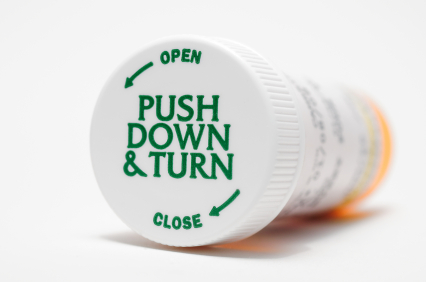Closures are essential in the packaging industry. A closure is a mechanical device that seals contents within a container and can be removed or opened to allow the contents to be dispensed. Often times, closures are not thought about until the cap is left off a gallon of milk, or the lunch meat is not properly sealed to ensure freshness, or more importantly our topic of discussion, a pill bottle is easily accessible to a child and your medication is mistaken for candy. There are two primary closure systems put in place to protect contents in the medical industry. The medical industry has taken careful consideration of closures to protect the contents and the consumer. The industry has in place tamper-evident closures and child-resistant closure systems.
Tamper-evident closures have an indicator or a barrier to the entry of the contents that will provide visible evidence to the consumer that tampering has occurred. (21 CFR 211.132). These closures are designed using a defensive strategy against tampering to make it more difficult to contaminate or steal the contents. If tampering occurs the customer will notice. The most common types of tampering closures used in the medical industry are film-wrapper, blister or strip packs, bubble packs, shrink seals and bands, foil paper, plastic pouches, bottle inner seals, tape seals, break-away closures, sealed collapsible tubes, sealed cartons, aerosol containers and miscellaneous other styles. The type chosen is based on the make-up of the contents to ensure there is no reaction between the contents and the closure. Though the design of the closure provides a defensive mechanism, no closure or package will ever be one hundred percent tamper proof. Another thing to keep in mind is that the packaging should be easy to open while it is effective in preventing tampering with the product. The key to successful packaging is the balance of tamper-proof and customer-accessible design.
The other closure that is unique to the medical packaging industry, are “child-resistant closures. ” Similar to tamper-evident closures, child-resistant closures are not one hundred percent child proof. Child-resistant closures and packaging is used to reduce the risk of poisoning in children via ingestion of potentially hazardous items. (CHPA.org) These types of closures are geared towards children under five years of age. Studies are conducted on 200 children between 42 to 51 months of age. (Fundamentals of Packaging Technology, 2014) The children are shown how to open the package and are given ten minutes to demonstrate again how to utilize the closure to open the package. The trick to opening these packages is to use dissimilar simultaneous motions and actions. After it is proven that the closure is at least eighty-five percent effective, it is then given to seniors and adults between the ages of fifty and seventy. Seniors are considered heavily in the medical industry versus any other industry because they spend five times more than younger adults. (Drug Development and Delivery, 2013) Senior citizens found opening medicine containers so frustrating and painful, they took shortcuts like leaving a cap loose or transferring pills to plastic sandwich bags. Measures to protect seniors and make closures senior friendly were put in place1.
They must be able to open the same closure types at ninety percent effectiveness (Fundamentals of Packaging Technology, 2014). Two of the most used child-resistant and senior-friendly closure techniques are “line up the arrows and lift” and “push down and squeeze while twisting. These tests rely heavily on cognitive skills verses physical strength. The new child-resistant closure systems have helped to drop child reported incidents eighty-four percent for all substances and ninety-eight percent effective for aspirin2.

The medical industry has made great strides in protecting the consumer utilizing design techniques around specialized closure systems. These closures help maintain sterility and the integrity of the packaged contents. This market has grown to over 20 billion a year (http://www.ncbi.nlm.nih.gov/pmc/articles/PMC3697200/). As with most other packaged goods, pharmaceuticals need reliable and speedy packaging solutions that deliver a combination of product protection, quality, tamper evidence, patient comfort and security needs (http://www.ncbi.nlm.nih.gov/pmc/articles/PMC3697200/). Scientists and engineers are constantly coming up with innovative approaches to bring technology to a packaging closure system. Many engineers say “Wouldn't it be nice—from the consumer's point of view—if some sort of standardization came into the field of pharmaceutical closures?1. In our changing world of technology, the standard seldom stays for prolonged periods of time. If I were to design a package for this, an electronic lock would be place on the contents that can only be opened using the prescriber’s social security number and date of birth.
References
Child-Resistant Closures: Is a Revolution in Design Imminent? (1998, April 1). Retrieved from PMP News: http://www.pmpnews.com/article/child-resistant-closures-revolution-design-imminent
Closures, Fundamentals of Packaging Technology, 5th ed, Institute of Packaging Professionals, 2014.
Drug Development and Delivery. (2013, October 16). Retrieved from Drug Development:
http://www.drug-dev.com/Main/Back-Issues/PACKAGING-SOLUTIONS-Overcoming-the-Challenges-of-C-637.aspx
amcor_secureplus_15ml_closure-Copy.jpg


































